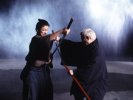Eye For Film >> Movies >> Zatoichi (2003) Film Review
Zatoichi
Reviewed by: David Stanners

Cult legendary Japanese actor/director Beat Takeshi (aka Beat Kitano, Takeshi Kitano) has conjured up a classic-style samurai epic, casting Japan's Sixties mythical hero, Zatoichi, a blind masseur and prodigious swordsman, into a modern day masterpiece.
Disciples of Akira Kurosawa's monumental achievements in Seven Samurai and Yojimbo (1961) will not be disappointed with Kitano's effort, which pays tribute to a classic genre, so often replicated in spaghetti Westerns.

Set in the waning years of Japan's Tokugawa Shogunate (19th century), the Samurai are losing their coveted status as sword bearing protectors of the land. Warring factions in the villages are rife. Law and order is fraying at the seams, in what was once a tightly stitched social hierarchy.
Zatoichi (Takeshi) - possibly a former samurai - wanders the countryside, scraping a living as a blind masseur with exceptional senses. When he befriends a widow (Michiyo Ookuso) and her son Shinkichi (Gadarukanaru Taka), a luckless dice gambler, he learns that a fraudulent Daimyo (landlords) duo is operating a money making racket at the local villager's expense.
When the villagers react and fights break out, the crime lord purchases the services of freelance bodyguard, Hattori (Tadanobu Asano), a roaming masterless samurai (ronin) and elite swordsman, to protect them from unwanted dissent. Hattori's methods are brutal, but honourable. His wife (Yui Natsukawa) is ill and his salary will pay for her medicine.
Zatoichi's sword-wielding skills become increasingly evident as he annihilates the hoodlums one by one, as well as making his presence felt down at the local casino, alongside his dice gambler friend Shinkichi. As the plot rhythmically unfolds to beating drums and harmonised actions - not unlike Stomp - two geishas are intricately woven into the tapestry. Their role is instrumental to the plot and, through a series of flashbacks, we learn how their family's tragic fate provides the link to the ensuing anarchy that pervades the village.
Kitano has done a tremendous job with this. The storytelling - a benchmark of all great Japanese films - is first rate and unravels slowly and subtly, building to an almighty crescendo between two classically trained craftsmen. The swordfights are beautifully choreographed, capturing the lightning quick splicing and dicing of each acutely measured stroke. Blood squirts regally, like great Roman fountains, or characters in Nintendo beat-em-ups.
Kitano is a man who has studied his craft meticulously. Attention to historical detail and the work of earlier masters, such as Kurosawa, are evident, but not too obvious. Little touches, such as Takeshi's peroxide blonde hair, add a funky edge to the thing and Kitano's deft touch is clear in some of the lighter, more comedic scenes. He's not short on twists, either.
Kill Bill: Volume 2? You've got your work cut out in the sword brandishing stakes.
Reviewed on: 18 Mar 2004



















